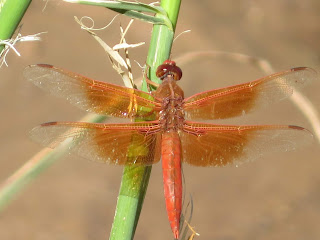Confirmation bias is a strong and prevalent issue with any naturalist running around with a magnifying glass and a camera. We always see what we expect to see, and fail to see what we do not expect. This simple concept can have weird ramifications.
As caterpillars grow in the canopy of those trees over the summer, the volume and size of their "frass", or poop increases. This picture shows a scattering of frass, which is digested leaves. It is not often appreciated how this frass becomes the soil amendment that changes sandy and clay soils into a rich growing medium. Earthworms are responsible for this process in colder, wetter climates.
The way moths use silk is very interesting too. Here the tent worms have begun to leave their protective and communal feeding sites that have protected them since their were laid in the spring.
The types of dragonflies has begun to be reduced lately as their season moves along. Some, like this flame skimmer have been around all summer.
It is kind of strange, but I am not seeing any large, adult lizards right now. These juvenile whiptails are learning fast, however. This one is ignoring me and focused on hunting for small insects in the undergrowth. These lizards have all sorts of fascinating adaptions to avoid being eaten, like speedy bursts of energy and disintegrating tails.
This one is sunbathing while also keeping a wary eye on me and the dogs I'm walking. This juvenile should know better than being this exposed.
This fence lizard is much more of a master of stealth and will hold still for as long as possible before making a run for it up the nearest tree. While he still seems too young, he sports a bright blue throat to advertise himself to other lizards.
This young woodhouse toad would have been invisible if it had held still. The ripples in the water attract all sorts of unwanted attention.
The garter snakes are active hunters of tadpoles and young toads. The recent rains seem to have encouraged some sort of migration. You can see the large eyes these snakes use for hunting, along with their fine sense of smell. They are usually found near water.
I spotted this little toad in the parking lot of Wagner's farms in Corrales. There are a few left from the spawning season this year but they should not be hopping around parking lots. I moved him to a nearby patch of dandelions.Many insects get labelled as a stink bug, but this one actually is in the stink bug family. They usually live on plant sap and most are agricultural pests.
A clouded yellow butterfly. There are so many species around at the moment, but the common yellow ones are pretty eye-catching.
Heidi's raspberry field has a lot of exciting things, but this hole in the end of a blackberry cane was the most fascinating. It is the brood chamber for some sort of native bee that has packed the stem with pollen packets and eggs.
Unfortunately, humans often see a tangle of roots as a source of wasps. This pile of wasp killer was left by a crew creating the foundation for a new house in the neighborhood. Using this kind of poison makes all sorts of problems for the local wildlife and does not bode well for the future of Corrales. There was also some sort of orb weaver spider than was hiding among the brambles. It is not as colorful as other species, but this individual had some fascinating behaviors while I sat and watched it for a few minutes.
The rains has stimulated many fungi species to put out fruiting bodies. You can see the cottonwood root in the background that this fungus is using to grow from.















No comments:
Post a Comment